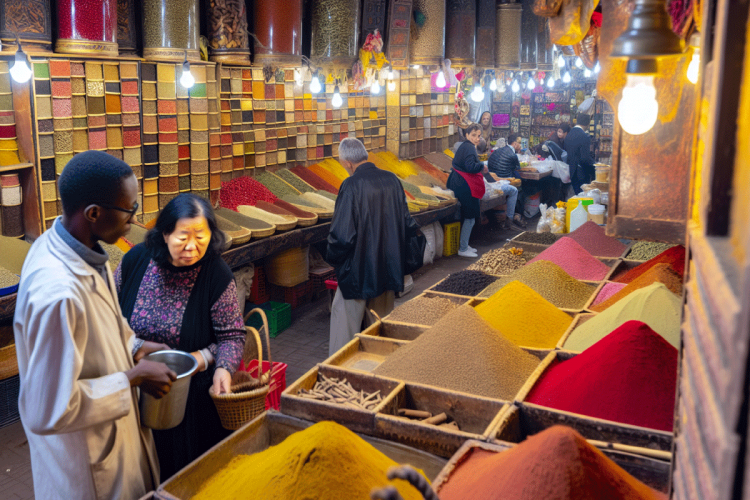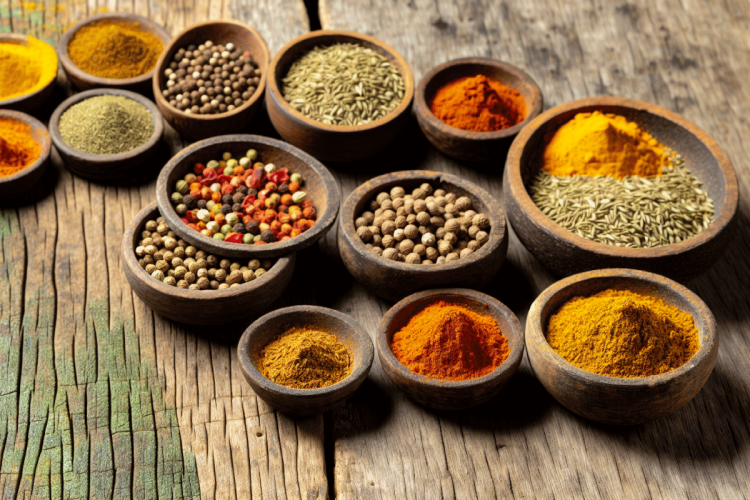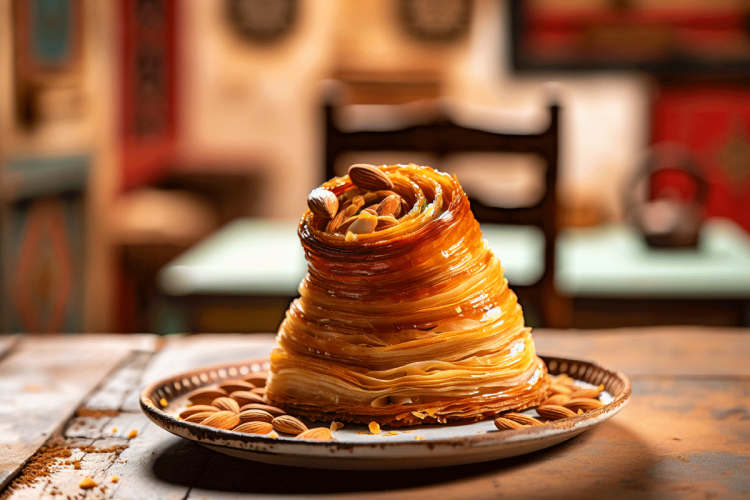Exploring the vibrant food of North Africa
Savor the spice.
Indulge in the rich and diverse food of North Africa; a culinary adventure spanning from the bustling markets of Morocco to the Nile-centered feasts of Egypt. This concise guide introduces you to the harmonious blend of spices, authentic dishes, and distinctive cooking customs that tell a story of cultural richness and variety. North African cuisine, with its rich and diverse flavors, represents some of the most delectable food in Africa.
Before the North African recipes
- North African cuisine is characterized by a rich diversity of flavors influenced by Arabian, Berber, Mediterranean, Ottoman, European (including French and Italian), and indigenous cultures, with each region adding its unique culinary touches.
- Iconic dishes like couscous royale, tagine, and ful medames highlight the cultural and regional diversity within North African cuisine, integrating a blend of meats, vegetables, and a symphony of spices like cumin, coriander, cayenne pepper, and turmeric.
- Cooking techniques such as tagine cooking and bread baking are deeply rooted in North African culinary traditions, reflecting a heritage that favorably combines time-honored methods with a communal approach to dining.
The rich tapestry of North African cuisine
From hearty stews infused with ras el hanout to couscous royale adorned with toasted almonds, North African dishes are a feast for the senses. Their complexity mirrors the diverse cultural influences that have shaped the region, while regional differences add further layers of intricacy.
We will delve into these influences and differences that constitute the rich mosaic of North African cuisine.
Cultural influences
North African cuisine is a confluence of influences from:
- Arabian
- Berber
- Mediterranean
- Ottoman
- European
- French
- Italian
These influences have been molded through a history of indigenous populations, trade, and conquests. Arab influences introduced spices like ginger, caraway, and saffron, and ground wheat in couscous, while European incursions brought Italian tomato-based sauces, French wines and cheeses, and British sandwiches.
Yet, the simplicity of Berber cuisine, utilizing basic ingredients such as corn and barley, has played a foundational role in shaping dishes across various regions. Fusion creations like pastilla embody the syncretism of Andalusian, Arabian, and Berber culinary traditions.
Amidst this diversity, North African cuisine adheres to Islamic dietary laws by predominantly utilizing halal meats. Dishes like Ful Medames, with roots in Pharaonic Egypt, testify to the enduring influence of these cultural traditions.
Regional differences
From Morocco to Egypt, each region adds its unique flavor to the North African culinary landscape. The familiar Maghrebi cuisines of Morocco, Algeria, and Tunisia offer a contrast to the distinct flavors of Libya, Egypt, Ethiopia, and Sudan. Egyptian cuisine, for instance, offers milder dishes that blend local flavors with Middle Eastern influences, a testament to the region’s historical role in the spice trade and conquests.
Berber cuisine varies significantly from one area to another within North Africa, resulting in a unique identity and taste for each dish based on its specific regional origin. In these communities, the choice of meals is influenced by the local availability of foods and personal finances, leading to a variety of regional specialties within North African cuisine. Whether it’s wheat for bread and couscous in the Maghreb or a variety of meats prevalent across different countries, the staple foods of North African cuisine reflect its rich regional diversity.
Iconic dishes of North Africa
North African cuisine offers a repertoire of iconic Moroccan dishes that capture the essence of its rich cultural and regional diversity. Some of these dishes include:
- Tajine: a slow-cooked stew
- Mechoui: a slow-roasted lamb dish
- Shakshouka: a spicy Tunisian dish made with eggs and tomatoes
- Mhadjeb: a popular street food delight
Each dish tells a story of tradition, innovation, and a shared culinary heritage.
Couscous royale
One can hardly talk about North African cuisine without mentioning Couscous Royale, a luxurious dish originating from the Maghreb. This gastronomic delight is a symphony of couscous grains accompanied by various meats such as lamb, chicken, and merguez sausages, all enveloped in a flavorful stew of vegetables. This dish holds a place of honor in Algeria, Morocco, and Tunisia, with each country offering its unique interpretation of the dish.
Intriguingly, the ‘royale’ version of the couscous dish, featuring a medley of meats and vegetables, is a Parisian twist catered to French palates, deviating from the Moroccan custom of serving couscous with one type of meat. The charm of couscous is in its adaptability. It accommodates a plethora of ingredients according to regional preferences, embracing:
- harissa sauce
- almonds
- sugar
- cinnamon
- a variety of meats
Tagine
Tagine, named after the conical clay pot it’s cooked in, is a traditional North African dish that combines meat, poultry, or fish with a variety of vegetables, fruits, and spices. Ingredients such as:
- olives
- figs
- apricots
- dates
- preserved lemons
The hearty stew-like consistency of tagine contributes to its signature sweet and savory fusion.
The complex flavors of Moroccan tagine are a testament to the intermingling of Arab, Turkish, Berber, and European influences, as witnessed through the various spices used. The array of tagine recipes is as diverse as the region itself. From meatball tagine in tomato sauce and chicken tagine with preserved lemons to vegetarian options like chickpea and carrot tagine, there’s a tagine to suit every palate.
Ful medames
Ful Medames, the national dish of Egypt, is frequently enjoyed as a popular street food in bustling cities such as Cairo and Giza. It is a must-try for anyone visiting these urban centers. The hearty dish is made with fava beans, vegetable oil, cumin, garlic, onions, and peppers, and it can be complemented with hard boiled eggs. It is a delicious and satisfying meal. It is traditionally accompanied by a variety of add-ons such as olive oil, cumin, chopped parsley, garlic, onion, lemon juice, and chili pepper, and occasionally topped with hard-boiled eggs.
The distinctiveness of Ful Medames lies in its adaptability. Although it’s a breakfast classic, it’s savored all through the day as a satisfying snack or meal, demonstrating its flexibility across various meals and times of the day.
A symphony of spices
If North African cuisine is a tapestry, spices are the vibrant threads that bring it to life. Some of the key spices used in North African cuisine include:
- Cumin
- Coriander
- Cayenne pepper
- Turmeric
These spices reflect the region’s rich historical influences and lend their distinctive flavors to a wide range of dishes.
We’ll analyze two central spice blends that form the essence of numerous North African recipes: Ras El Hanout and Harissa Paste.
Ras El Hanout
Ras El Hanout, meaning ‘head of the shop’ in Arabic, is an essential spice blend in North African cooking. Each family has a distinct version of this blend, a testament to its flexible nature and the creativity it inspires. The blend traditionally encompasses a symphony of spices such as:
- cardamom
- nutmeg
- anise
- mace
- cinnamon
- ginger
- turmeric
- various peppers
Some blends even include premium ingredients like Tellicherry black pepper and Spanish saffron for an extra flavor punch.
In Moroccan cuisine, Ras El Hanout holds a place of honor. It is a key ingredient in tagines, imparting a unique flavor profile that is both familiar and exotic.
Harissa paste
Harissa paste, a fiery blend from the Maghreb region, is another essential component in North African cooking. It is made with a mix of:
- roasted red peppers
- Baklouti peppers
- spices
- garlic paste
- caraway and coriander seeds
- cumin
- olive oil
This hot chili pepper paste is frequently used to enhance the flavor of stews and various other dishes, adding a spicy kick that is unmistakably North African.
Tunisia, the largest exporter of prepared harissa, acknowledges its cultural significance by having it recognized as part of the country’s Intangible Cultural Heritage by UNESCO. The heat level of Tunisian harissa varies, often featuring peppers from Nabeul and Gabès that score 4,000–5,000 on the Scoville scale, a measure of the spiciness of chili peppers.
Delectable desserts
No culinary journey is complete without indulging in desserts, and North African cuisine is no exception. Infused with honey or syrup and aromatic elements such as rose water and orange blossom water, North African desserts are a testament to the region’s sweet culinary delights.
We’ll delve into two favored desserts: M’hanncha and Ancient Egyptian Rice Pudding.
M'hanncha
M’hanncha, known as the ‘Moroccan snake’ or ‘snake cake,’ is a coiled filo pastry delight filled with almond paste, orange flower water, and pistachio. This exquisite dessert is as beautiful to look at as it is delicious to taste. The almond filling comprises:
- ground almonds
- confectioners’ sugar
- melted butter
- almond extract
- orange flower water
All encased in a golden, flaky filo pastry, perfect for enjoying with a side of succulent lamb chops and a sprinkle of pine nuts, our whole lamb dish is a must-try.
Once baked to a golden brown hue, M’hanncha is sprinkled with confectioners’ sugar and cinnamon in a distinct lattice pattern, elevating its aesthetic allure. This dessert can be enjoyed warm or cold, making it a versatile sweet treat.
Ancient Egyptian rice pudding
The Ancient Egyptian Rice Pudding is a creamy dessert made with:
- Short-grain Calrose rice: This type of rice is known for its ability to absorb more water, contributing to the pudding’s creamy and thick consistency.
- Sugar: To enhance the sweetness of the dessert.
- Vanilla: To add a rich aroma.
- Heavy whipped cream: To increase its richness.
Raisins and coconut are favored additions to the Egyptian Rice Pudding, imparting a pleasing texture and an enhanced flavor profile. Garnishing options for this dessert are extensive, often including:
- cinnamon
- raisins
- cream
- roasted nuts
- pistachio
- white honey
- coconut
Some variations even feature layers of peach pudding, flan, or ice cream.
Cooking techniques and traditions
North African cuisine is not just about the ingredients but also about the techniques and traditions that have been passed down through generations. From communal eating to tagine cooking and bread baking, these practices reflect the region’s rich culinary heritage and diverse influences.
Tagine cooking
Tagine pots are earthenware vessels with a round base and low sides, available in various forms such as:
- unglazed
- glazed
- aluminum
- cast iron
Each offering different cooking experiences. The conical lid of the tagine pot is specifically designed to circulate steam and allow it to condense back into the dish, ensuring the food remains moist and the flavors are more concentrated.
Cooking in a tagine involves:
- Layering vegetables at the base
- Adding olive oil
- Adding meat
- Adding additional vegetables
- Adding spices
- Adding a liquid
Then, slow cooking the mixture over low to medium heat. The use of tagines reflects the Arab and Berber culinary heritages of the Maghreb region, with regional variations influencing the preparation methods and interpretations of tagine dishes.
Bread baking
Bread is a cornerstone of North African cuisine. Whether it’s the flatbreads of Egypt or the round loaves of Morocco, bread baking is a cherished tradition that forms an integral part of both daily meals and festive celebrations.
Time to explore
Exploring North African cuisine is like embarking on a culinary odyssey, one that takes you through a rich tapestry of flavors, textures, and traditions. From the hearty tagines of Morocco to the spicy harissa of Tunisia, from the communal meals of Algeria to the street food delights of Egypt, each dish tells a story of a vibrant and diverse region. As you savor the symphony of spices and relish the delectable desserts, you experience a cuisine that is a testament to a rich historical past and a vibrant present. So why not embark on this journey and discover the vibrant food of North Africa for yourself?
What is North African cuisine called?
The cuisine of the North African region is called Maghreb cuisine, which includes dishes like couscous, pastilla, and tajine. These dishes are commonly found in countries like Algeria, Libya, Mauritania, Morocco, and Tunisia.
What is the main grain eaten in North Africa?
The main grain eaten in North Africa is wheat, with wheat and wheat by-products being widely consumed in the region, often in the form of couscous.
What is the traditional food of Africa?
The traditional food of Africa includes a variety of dishes made with starchy items, meat, fish, and a wide array of spices and herbs, such as rice, black eyed peas, brown beans, and root vegetables like yams. These ingredients are used in meals like fufu, banku, couscous, and garri, served alongside soups and stews.
Is North African food spicy?
Yes, North African food can range from simple and non-spicy to complex and hot, with slow-simmered stews, charcoal-grilled meats, and rich pastries being common.
What are some common spices used in North African cuisine?
Common spices used in North African cuisine include cumin, coriander, cayenne pepper, and turmeric, reflecting the region's Arab influence and historical spice trade connections.




